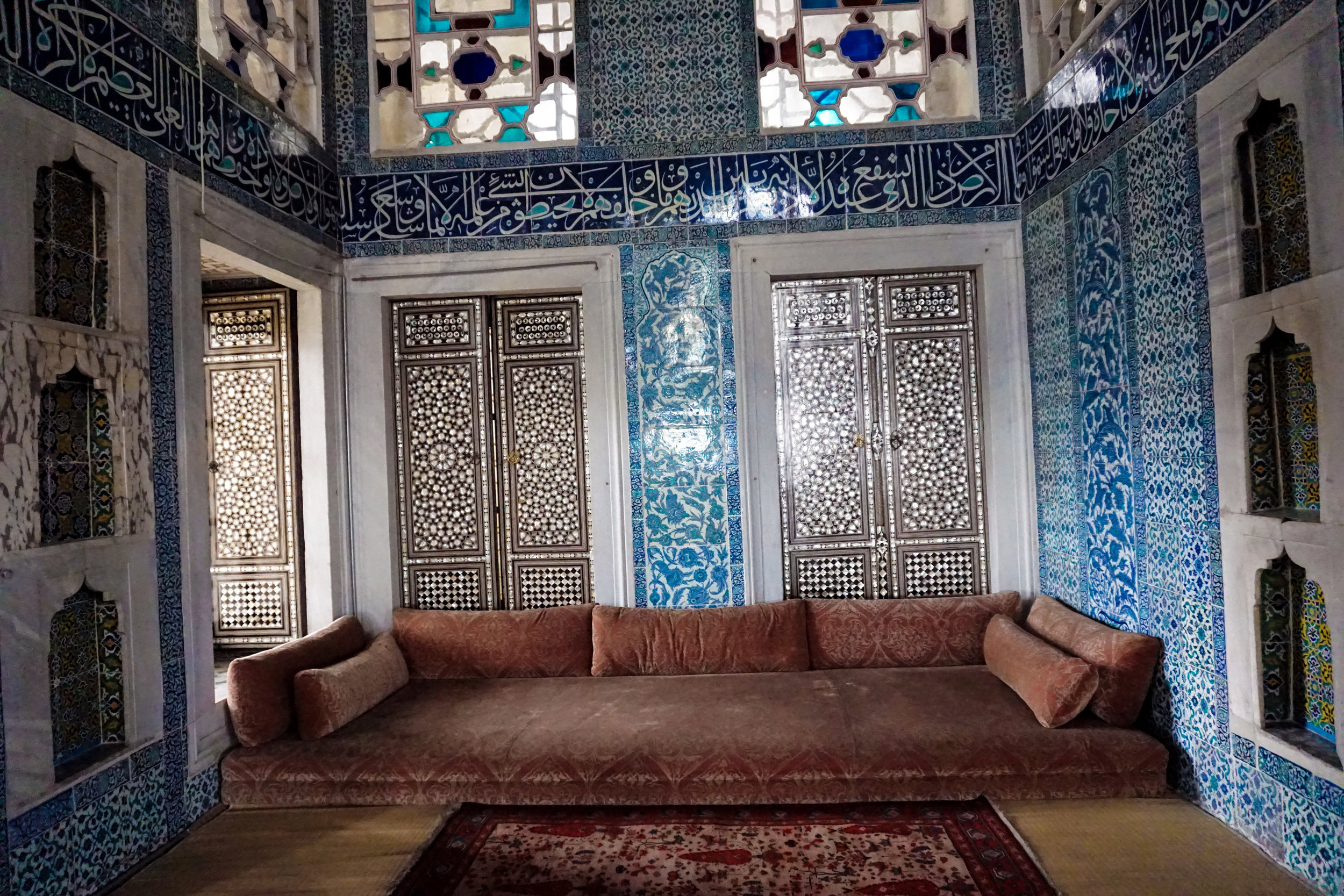TOURING ISTANBUL: Topkapi Palace
Dear Foodie Fam,
You know when you first type your destination city into Pinterest’s search bar? That moment you are bewitched by a certain photo pin? When I typed “Istanbul” into that rabbit-hole-search-engine of Pinterest and came across the Topkapi Palace, I surprised myself…
I usually prefer experiential rather than famously “picturesque” destinations, so it was hard to admit I wanted to see the Topkapi Palace. I put it on my “secondary” Istanbul-to-do list. (The primary list included: Hagia Sophia, Blue Mosque, Galata Bridge, a ferry to cross the Bosphorous to the Asian side of Istanbul… and the obvious number of restaurants I borrowed from our Mark Wiens’ v/blogs.)
On most of our travels, Dutch and I have a no-agenda-exploration day. On this day, we walked down the short street from our hotel to say “good morning” to the Hagia Sophia and Blue Mosque. Then, we turned to follow the metro rails down Alemdar Cd.
We were met by a wall and archways. We’d passed it a few times in our explorations but hadn’t given it too much thought... but…
That morning, there were hoardes of school aged kids lining up and running through the archway behind smiling teachers who waved colored flags. The familiar “field-tripy” buzz of excitement filled the air. We were enveloped by crowds of kids taking selfies on cell phones and plowing through canary-yellow leaves blanketing the dewy dirt! Some teachers visibly struggled to fit all their kids with them into one selfie so I offered:
“Bir, iki, üç!”
…Dutch and I looked at each other and shared one of those “this place must be poppin’” looks.
After grabbing some delicious pastries from a vendor, we walked right in to investigate…
Lo and behold! We found ourselves at the endlessly handsome Topkapi palace!
“Topkapi” means “Cannon Gate”- a strong name for a palace that is now the largest tourist site in Istanbul! In it’s time, it was the largest palace in the world.
Built six years after the Ottomans took Constantinople, its was the the Sultan’s home and political center. It’s irregular layout is a result of the individual renovations and whims of 300 consecutive residing Sultans.
By 1856, Sultans moved to the more modern palaces across the Bosphorous, like the Dolmhabace. Topkapi Palace is now a museum and a UNESCO World Heritage site.
There’s 100s of chambers but these are the main parts:
KITCHEN:
Outside the Kitchen halls.
No visitor photography allowed.
My favorite kitchen ever! It was one of the original buildings in the Palace. Under ten domes once sat a confectionery, a creamery, storerooms and even cook’s rooms. Here you see the Sultan's kitchenware: gold, copper, glass and porcelain 100s of years old. Some of these are actually rumored to have changed color when touching poison!
Exhibited are intricate, ethereal porcelain collections gifted by Japan, Germany, France, Austria and Russia. There’s porcelain from four different Chinese dynasties. There’s even pots so huge you could bathe in them! The ceiling in that room is a vent. These are the same pots that were stirred by 1,000s of cooks who prepared food for 100,000 people at once!
AUDIENCE CHAMBER:
Inscription over a fountain just outside the Audience Chamber.
The “Arg Odasi” (Chamber of Petitions) was where the main throne room was located. This is the Sultan’s private space and where he conducted the high business of the state. The throne, covered in gold cloth and precious stones was surrounded my luxurious pillows and mosaics. Inscriptions, patterns of greenery, dragons and birds adorn the ceilings and entrances. The “besmele” (Muslim benediction) crowns the main entrance. A fountain at the entrance symbolizes generosity, justice and beneficence. One would leave gifts at a window on the left.
COUNCIL ROOM:
The Grand Vizier and state officials conducted business, here. There’s several entrances to the council room. Within the room, the Sultan could pass through an entrance from the imperial quarters and sit undetected behind a golden grill and witness deliberations. The Tower of Justice -a lookout to the harbor- sits between the harem and the council room. It’s soars above every structure in the palace, and can be spotted from the Bosphorus.
HAREM: (“forbidden” in Arabic)
You need a separate ticket to enter this area. With six floors and 400 rooms, this is where the Sultan lived. It’s also where consorts and favored officials lived. Most importantly, it was home to the Sultan’s mother, wives and children lived. The Crown Prince has his own apartments. The 300 concubines had their own section where they were trained in many phases before only the most attractive and talented entertained the Sultan. Many left the palace at 16 or 17 years of age. The Sultan and Queen Mother have the largest, most impressive groups of apartments and their own private baths. There’s also the courtyard of the favorites, which ironically can be seen from “The Cage” where brothers and sons of the Sultan were imprisoned. The “Golden Road” is past this courtyard and connects the Harem Eunuch’s section to the privy chamber on one side and the circumcision room on the other. The official reception hall is where the Sultan entertained his closest confidants, mother, first wife (“Valide Sultan”) of four (“Kadin”), consorts, and his children. A secret door behind the mirror serves as the Sultan’s private entrance.
4th COURTYARD:
Of four courtyards, this is my fave. It’s where the Sultan watched sports games held below and where he sipped his tea overlooking his tulips.
There’s several kiosks here, like one that served as a 40-day religious retreat.
Past the Royal tulip garden is the Iftar Kiosk, a marble terrace with a pretty pool, three pavilions and a sprawling view of the city. It’s a precedent of Chinese and Indian inspired architecture where many take selfies!
The Sultan made this to be a spectacle. It’s where he always broke his Ramadan fast.
Past the Iftar Kiosk is the last addition to the Palace, the The Grand Kiosk. It has a famed panoramic view of the Sea of Marmara and the Bosphorus. The Palace sits on one of the highest points jutting into the Bosphorus. This is exactly where the Ancient Greek city of Byzantion’s acropolis stood.
Today, you can eat at a restaurant next to the kiosk where the likes of Queen Elizabeth II, Jackie Kennedy and Mohammed Ali have eaten. It overlooks the Bosphorus and the Asian side of Istanbul.
TREASURY (“hazine”):
One of the most stunning armories in the Islamic world. See 400 pieces -helmets, swords, daggers, guns and entire suits of armor- most inscribed and owned by various prophets, Sultans and high ranking warriors.
PRIVY CHAMBER:
No visitor photography allowed.
This is my favorite experience in all of Istanbul. Even as a Christian, I felt so honored to see the most sacred relics in the Islamic world. You are not allowed to photograph anything, but don’t feel bad… not even the Sultans were allowed to enter more than once a year (during Ramadan.)
Under low light, devout Muslims on pilgrimages and tourists alike visit the breathtakingly revered exhibits. There’s the first caliphs’ daggers, sure. There’s Joseph’s turban, Abraham’s pot, David’s swords and Moses’ staff. However, it’s the Prophet’s belongings -the Sacred Trusts- they are here for.
On display are the cloak, swords, bow, tooth, footprint, hair, Blessed Mantle and Holy Banner of Muhammad. Adding to the ambiance, in the same room sits a mufti who reads from The Qur’an. His voice echoes through the hall, emitted from speakers overhead.
I will leave you with some photos I took of the details left by the Sultan’s most skilled craftsmen. Maybe it’ll arrest you with wonder, too.












































